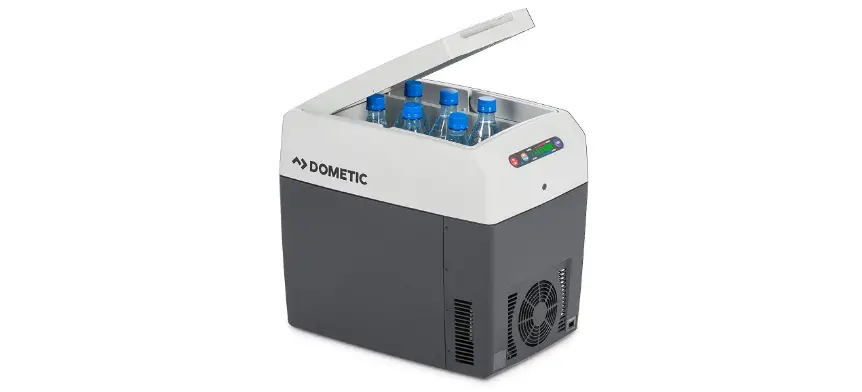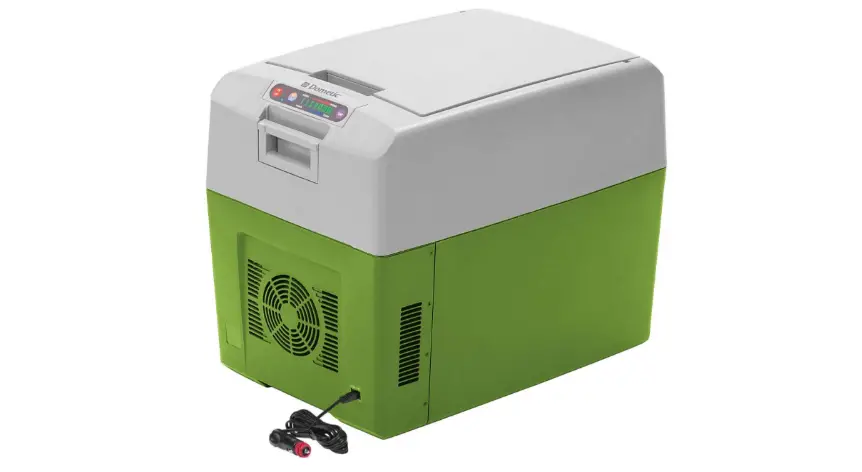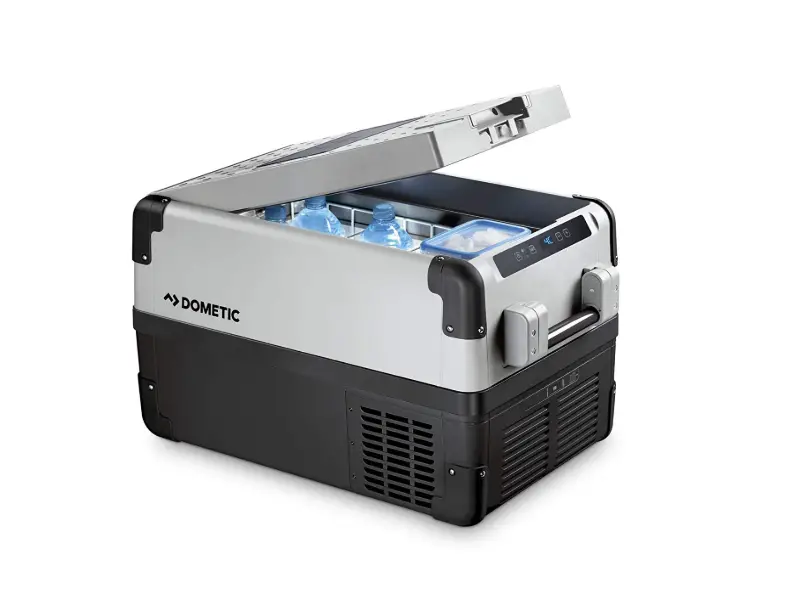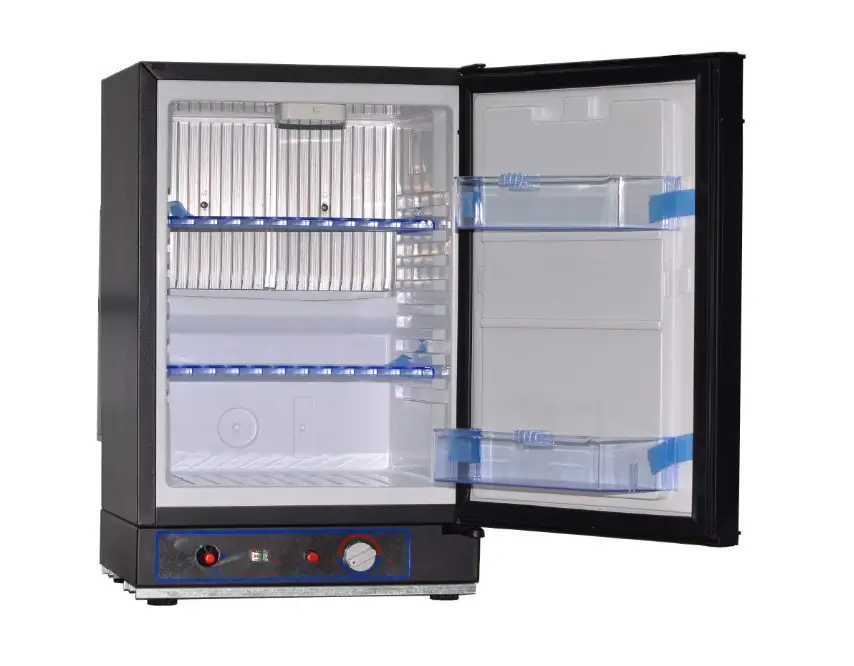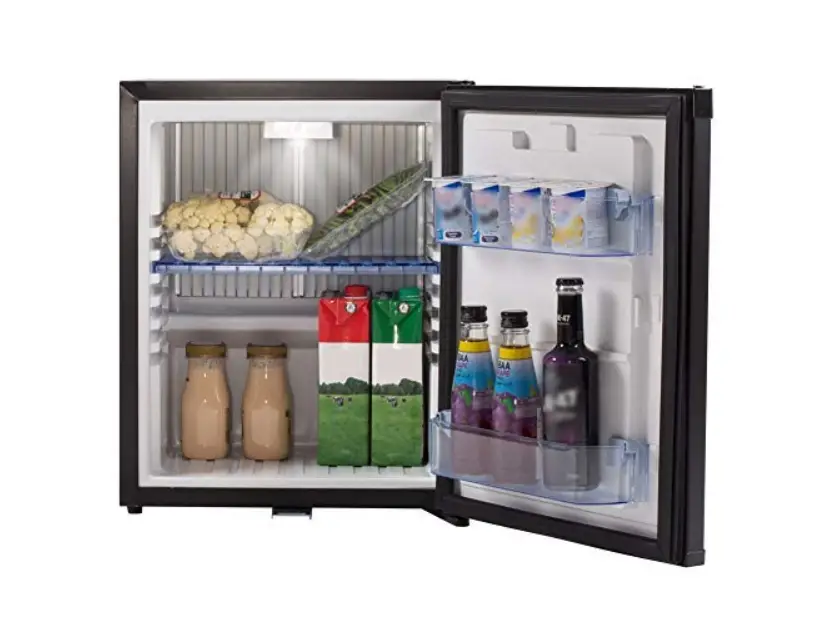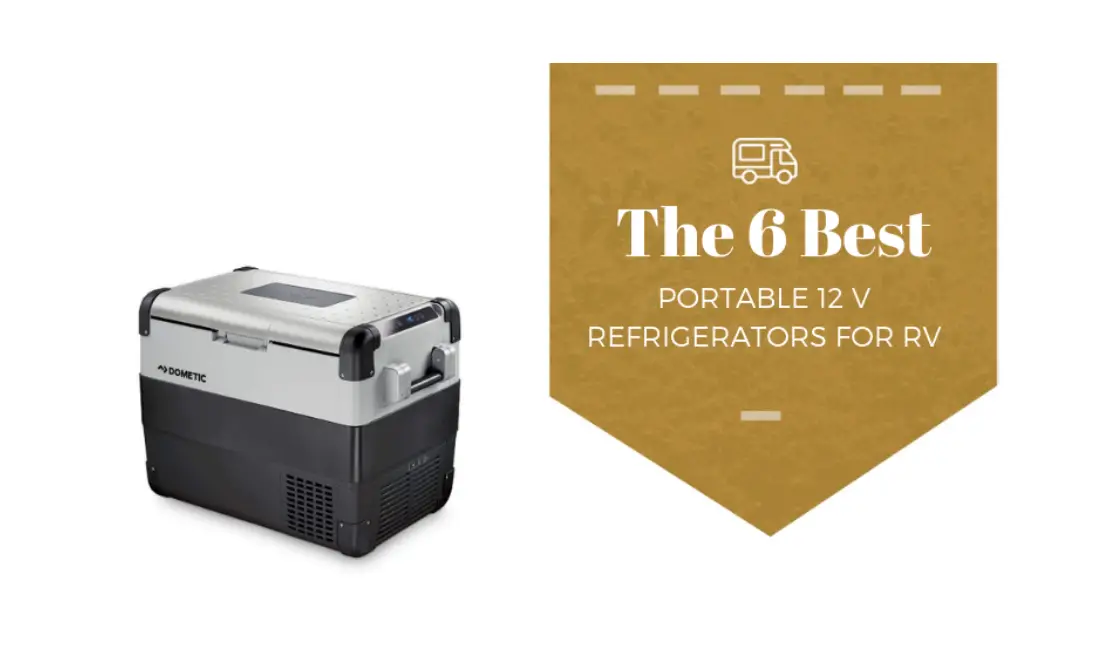
6 Best Portable 12 V Refrigerators for RV
When you’re traveling for long periods of time in an RV, it’s important to have a means of keeping your drinks cool and your food well preserved. Most mini-fridges are not suited for RVs and the portable life because they’re either too big or draw too much energy from your RV. That’s why it’s important to purchase a specialized refrigerator for your RV.
A 12 V refrigerator is a small portable refrigerator meant to be used in cars, camper vans, RVs, etc. It is designed to work with just 12 volts of power, so you can connect it to a car cigarette lighter or other power source that generates only around 10 to 15 volts of power. These refrigerators differ on their power source, be it thermoelectric, compressor , or absorption type, and some based on how the door is opened. While all of them have their sets of advantages and drawbacks, the compressor refrigerators are generally considered to be the best — and most expensive — of the bunch.
A portable 12 V refrigerator can be used in a number of ways. While they are meant for the portable life in camper vans and RVs, they can just as well be used in hotels and homes as well. The following are the prime uses of these refrigerators:
- Camping: If you’re going out into the wilderness for an extended period of time, you’ll need some means of ensuring that your food and drinks are kept preserved and cool. This can be done with a 12 V refrigerator for RVs.
- Road Trip: If you’re going on a long road trip in your RV, you’ll need a 12 V refrigerator that can withstand all the bumps along the way and can keep your beverages cool.
- Cabin: If you have a cabin that you escape to every now and then, you can stock it up with a 12 V refrigerator as they are durable and don’t consume a lot of power.
There are a lot of different of portable 12 V RV refrigerators to choose from and it can be a bit overwhelming, so I have done the hard work for you and listed the best product in each category right here.
Table of Contents
Best Thermoelectric Portable 12 V Refrigerators for RV
A portable thermoelectric RV refrigerator works on the basis of the Peltier effect, i.e., it keeps food cool by passing a current between two plates of semiconductors, thus facilitating the transference of heat. The cooling plate — the plate that loses heat — is placed inside the refrigerator and the heating plate (the plate that gains heat) is placed outside. As such, heat from the inside is transferred to the outside.
The best aspect of a thermoelectric RV refrigerator is that it can also be used as a warmer. With a single button, you can turn the internal plate into the heating plate and the external plate into the cooling plate. As such, heat will move from outside to the inside, warming up the food. This makes portable thermoelectric RV refrigerators ideal for those who travel far and wide, changing from warm climates to cold conditions.
However, if your purpose is to keep food really cold or to freeze it for a long duration, this is not the best option for you. It doesn’t work well in really hot conditions and can only go down to 40 degrees Fahrenheit. As such, it cannot be used as a freezer.
Pros:
- Great for occasional day trips.
- Can be used to cool and warm food.
Cons:
- Can’t keep anything cool if the ambient temperature exceeds 77 degrees Fahrenheit.
- Generates a lot of noise.
- Consumes 3-5 amps of power, which is a lot of battery.
- Cannot manually set the temperature.
1. Domestic Gray Tropicool TC21
The Dometic Gray Tropicool TC21 is a great 12 V refrigerator for short RV trips. It uses a thermoelectric system of refrigeration so it can be used to both cool or heat the interiors, though only to a limited range.
Since this is a thermoelectric refrigerator, you cannot moderate the exact temperature with it, you can merely set up the difference between ambient (atmospheric) and interior temperature. You can set it up to be 20º C cooler than the ambient temperature. The maximum temperature difference possible is 30º C and the minimum is 1º C.
Thermoelectric refrigerators work on the basis of the displacement of heat between two plates. A simple button turns the cooler into a heater and you can heat the contents of the fridge. The lowest cooling temperature available is 1º C and the hottest possible is 65º C. As you can see, this refrigerator is enough to cool or warm dishes, but it cannot maintain frozen food. The ECO mode is pretty useful as it maintains a steady temperature within the cooler and doesn’t consume a lot of energy.
You should also note that even though the minimum possible temperature is 1º C, it can only be maintained if the ambient temperature is 25º C or lower. If the ambient temperature rises, the minimum possible internal temperature will also rise accordingly. If you’re in an extremely hot environment, the cooler will be rendered almost completely inefficient. To prevent this, you should keep it away from direct sunlight and in an area with some shade, so its ambient temperature is kept lower.
When you’re using this refrigerator, it’s important not to cover up the vents. The air needs plenty of space to circulate in and out; otherwise the interiors will not cool at all if the hot air cannot be displaced.
This is a chest-style cooler so the lid opens from the top. This is a useful design because it maximizes storage space, ensuring that cold air isn’t displaced when you open it, and making it more energy efficient. The lid can also be detached if necessary.
The Dometic Gray Tropicool TC21 is a powerful thermoelectric refrigerator. However, like all such refrigerators, it’s only suitable for short trips: for example, going to the beach and keeping a few bottles of water cool.
Pros
- Can be used to warm or cool food.
- Can be used with both AC and DC connections, so it can be plugged into a wall outlet or powered with a cigarette lighter.
- Plenty of storage space.
Cons
- Inefficient in extremely hot conditions.
- Not suitable for long trips.
2. Dometic TC-35US
Weighing only 22 pounds, the Dometic TC-35US is considered to be one of the most lightweight portable 12 V refrigerators for RVs. Like the Dometic Gray Tropicool TC21, it is a thermoelectric refrigerator, so it comes with the same drawbacks.
You can only use this refrigerator for short trips occasionally. There is no means of setting an exact temperature; you can only set up the difference between ambient and internal temperature. As such, if the ambient temperature is extremely high, this refrigerator will be rendered ineffective. This refrigerator can only go down 45º F from the ambient temperature, so it has an even lower range than the Dometic Gray Tropicool TC21.
It’s really small in size so you can stow it anywhere at all, but be sure to keep the top clear as its lid opens from the top. Furthermore, you should keep it in an area with shade to minimize its immediate ambient temperature. The lid is detachable with a magnetic lock so it’s easy to clean as well.
What I liked most about this cooler is that it comes with solid polyurethane foam insulation. This ensures that the contents are kept cooler and minimizes the amount of cold air that “leaks” out. As such, it remains cooler and consumes less energy. Furthermore, you don’t need to be concerned about purchasing a separate insulation cover, though you can if you choose to do so.
Another similarly energy-efficient feature is the power-save circuit that automatically switches off the power the moment the necessary temperature is reached. Later, when the temperature rises, the power will automatically turn back on. Thus, it’s only actively working when necessary, saving a lot of energy.
It also comes with a dust-proof and moisture-proof keypad that displays the current temperature in the cooler. This allows you to gauge not just the ambient temperature difference, but also the actual current temperature within the cooler.
You can also power it with a car battery; however, you should minimize the cooler run time with the engine turned off to just about an hour or it might drain your car’s battery. If the ambient temperature is cold, and so is the refrigerator, it might be able to maintain the desired cold temperature through the night.
Pros
- Great insulation provided.
- Energy-Efficient.
- Can be powered with both AC and DC connections.
- Power turns off automatically when the temperature is achieved.
Cons
- If you’re using it with a car battery, it can drain it dry if you’re not careful.
- It’s easy to block the air vent if you’re not careful.
Best Compressor Portable 12 V Refrigerators for RV
Compressor-type portable refrigerators are the most similar to home refrigerators because they use compressors for power. They work with the help of a cooling agent, condenser coils, expansive valve, and evaporator coils. The cooling agent is turned to liquid at temperatures below -15 Fahrenheit, used to cool the refrigerator from inside.
Out of the three portable refrigerators mentioned on this list, these are the most commonly used and popular. They’re also the only ones in which you can manually set up a temperature, so they can be used both as a fridge and a freezer. Some of them come with partitions, so you can use one as a freezer and the other as a fridge.
If the external ambient temperature rises drastically, the internal temperature can be affected, but only slightly. As such, external temperature isn’t much of an issue for compressor-type portable RV refrigerators.
These refrigerators don’t run constantly, but they power on and off to retain an established temperature point. This also makes them more energy efficient, and they consume only about 1 amp/hr. If the ambient temperature rises, they have to work harder and longer, so the power consumption also increases in response to the ambient temperature.
They also stop working automatically if a low-voltage level is sensed. This ensures that they don’t completely drain your RV’s batteries.
Pros:
- Low power consumption.
- Can manually set the temperature.
- Can work on both level ground or an incline.
- Can be used as a fridge, freezer, or both.
3. Dometic CFX35W
The Dometic CFX35W uses compressor technology to provide “true refrigeration”, i.e., it acts just like an actual home refrigerator, but is small and portable. It has a temperature range of -22º to +10º C so it can function either as a fridge or a freezer, and it comes in capacities of 27 to 90 quarts, depending on your needs.
This 12 V RV refrigerator is the perfect appliance to take on long road trips or if you live your life in an RV. I have found that most 12 V compressor refrigerators can only cool to about -18º C, but the Dometic CFX35W can cool to -22º C, making it ideal for deep freezing purposes as well. As such, it can be used to preserve frozen food, preserve ice cream, etc.
While I appreciate the sub zero temperature range, I do have one major issue. There’s a single compartment in this model, so you can set it up to a single temperature and can either use it as a fridge or a freezer, not both. I would prefer to have at least two separate compartments for different temperature needs. In its current form, I find that I can either store water bottles and soda or frozen food, but not both.
Having said this, I appreciate that this portable refrigerator comes with a number of useful features. For one, they have interior LED lights so you have visibility in the dark. But what I really love is how its handles can be taken apart and the lid can be taken off to facilitate cleaning or to make it squeeze into a tight space. These features are pretty handy when using the fridge in an RV. It also comes with a USB port which you can use to charge mobile devices, another thoughtful feature that helps save space. It further has an essential battery protection feature in place to prevent it from completely draining your vehicle’s batteries.
This product has been marketed as weatherproof; however, you should be careful about testing its limits. Yes, you can use it outdoors. However, if it’s raining heavily, it will eventually start filling up with water because it’s not 100% waterproof. I tested this out by placing it under a shower. This wouldn’t have been much of an issue if Domestic hadn’t put up the misleading claim that it’s completely waterproof.
Pros
- Acts like a real refrigerator with a temperature display and modulation features.
- 3-stage battery protection to prevent it from draining your vehicle’s battery.
Cons
- Has only one compartment.
- Not 100% waterproof as advertised.
4. Dometic CFX 65DZ
My biggest issue with the Dometic CFX35W is its single compartment that prevents you from using the fridge for both cooling and freezing simultaneously. However, the Dometic CFX 65DZ addresses this issue perfectly. It’s a dual-compartment compressor technology portable 12 V refrigerator for RVs. You can independently set up the temperature for both compartments, and you can use one side for deep freezing and the other for simple cooling. I love this feature because it allows me to store both ice cream and cold drinks without fear of one melting or the other freezing!
You have to set up the deep freeze temperature for one of the compartments in this refrigerator, and then the cold air from that compartment spills into the next one, keeping it cool. As such, you can only set up a precise temperature for the freezer and not the refrigerated section. I didn’t personally mind this feature very much, but I know a few people who were disappointed that they couldn’t set up a precise temperature for both compartments.
Similar to the Dometic CFX35W, this fridge also has an impressive range of -22º C to 10º C. However, if the ambient temperature goes above 32º C, its ability to cool is compromised, and it can no longer achieve the minimum temperature of -22º C. The temperature display gauge can help you set the precise temperature with 1º C increments. If you want to reach the desired temperature fast, you can set it up on Turbo Cooling mode to make the compressor work rapidly and achieve the desired temperature almost instantly. It comes with a 3-level battery monitor that can automatically turn the fridge off and prevent it from draining the vehicle’s battery.
As you can see, I don’t have a lot of complaints about this refrigerator. If I had to get nit-picky, I might complain about the WiFi app. The app can be used to control the temperature of the refrigerator from a distance of up to 100 feet, which is great, of course. However, when you connect the fridge to your phone, you cannot simultaneously connect other devices to your phone, making it quite like Bluetooth. This can be an annoyance for some, but it’s not a big issue for me.
Pros
- Noiseless with an operation range of 37 dB to 42 dB.
- Dual zone so you can use it as both refrigerator and freezer.
- You can set temperature by precise 1º C increments.
- 3-stage battery protection.
- Functions perfectly even when placed on an incline of 30º.
Cons
- You can only set the specific temperature for the freezing zone. The refrigerated compartment is cooled when the cold air spills over to it.
- If you connect this device to the phone over the internet, you cannot connect any other devices to your phone simultaneously.
- If the ambient temperature goes above 32º C, the minimum achievable temperature of -22º C is no longer possible.
Best Absorption Portable 12 V Refrigerators for RV
These are the most power-hungry refrigerators of all three types out there. They consume ten times as much power as compressor refrigerators and generally need a jump-start. You should not run these off your RV battery but use a separate set of dual batteries. You can also run them on gas, but you’ll need a lot of gas to keep them powered in the long run.
These refrigerators can only go about 30 degrees below the ambient temperature, so they’re pretty inefficient in extremely hot conditions of over 80 degrees Fahrenheit. Furthermore, they only function if placed on a completely even ground. This makes them unsuitable for use in campgrounds, where the ground won’t always necessarily be even.
While these refrigerators can be used in RVs, they are also the largest in size among the three types, so they’re not highly recommended.
Pros:
- Can run on battery power or gas.
- Efficient when running on gas power.
Cons:
- Can only run on perfectly even ground.
- Temperature cannot be moderated.
- Can only cool about 30 degrees below ambient temperature.
- Consumes 10x as much power as compressor refrigerators.
- Larger in size.
5. Smad LP Gas Electric 3-Way Absorption Refrigerator
The Smad LP Gas Electric 3-Way Absorption Refrigerator is not my preferred choice for a portable 12 V refrigerator for RVs. Personally speaking, I avoid using absorption refrigerators altogether because they’re extremely power hungry and consume ten times as much energy as most compressor refrigerators.
However, some people appreciate the fact that these function through various power sources — 110V, 12V, and propane. I’ve mentioned this here for those who prefer absorption refrigerators. You should note that it’s extremely power intensive so don’t connect it directly to your vehicle’s battery; use separate batteries. If you’re using gas, a 20 pound gas tank should last you a month. This is a great option if you’re going camping and won’t have access to electricity. However, it doesn’t come with an adapter, so you have to purchase the regulator and hose separately.
Another feature I like is its upright design. Basically, it looks like a mini version of a regular refrigerator. You open it from the front, and you can stack up your dishes on the various shelves. The advantage here is that you can stow it under shelves and countertops, so it takes up less space. But this comes with a disadvantage. Most portable RV refrigerators are designed in a chest-style, so the cold air doesn’t leak out upon opening it. However, in this refrigerator, the cold air can leak out, making it even less efficient.
This refrigerator is extremely quiet, producing only a faint 30 dB sound, which is barely even discernible.
Pros
- Can run on electricity, battery, or gas.
- Can be used in campgrounds without an electricity source.
- Upright refrigerator so it saves a lot of space in the RV as it can be built under shelves.
- Noiseless operation.
Cons
- Not at all energy efficient.
- Doesn’t come with a propane tank regular and hose.
- Cold air leaks out when the door is opened.
6. SMETA Mini Fridge
The SMETA Mini Fridge is a powerful absorption refrigerator available in sizes ranging from 1.0 Cu ft to 1.6 Cu ft. It can work on AC or DC power and comes with a single reversible door. It’s power intensive and only cools to a single temperature. It works on the basis of silent absorption technology, so there’s no noise produced and you can use it without any additional cooling refrigerant.
If you use 12 V for operation, it will run constantly. However, if you use 110 V, it can be adjusted using the thermostat to work only when necessary and stop when the ideal temperature is achieved. You can also operate it with solar panels, as long as they can reach the necessary 12 V supply.
It cannot cool instantly. As such, before you start using it, you should allow it to cool and reach the cooling temperature for an entire night. Furthermore, you shouldn’t use it to store frozen food, as it will defrost and leave a puddle behind. This is meant for simple refrigeration and can maintain its temperature for a long time.
Like the Smad LP Gas Electric 3-Way Absorption Refrigerator, this is an upright model. You can squeeze it in the space below a countertop for efficiency. However, upon opening the door, the cold air will leak out, an issue common to all upright refrigerators.
Pros
- Extremely silent.
- Can maintain cold temperature well.
- Can be placed under a countertop or shelves.
Cons
- Can’t be used as a freezer.
- Takes a long time to cool.
- Uses a lot of energy.
- Doesn’t work with propane gas like a lot of other absorption refrigerators.
Which Factors to Consider when Buying Portable 12 V RV Refrigerators?
The following are the primary factors to consider when buying a portable 12 V RV refrigerator.
Cooling Ability
Refrigerators come in the form of coolers, freezers, or both. Coolers can only be used to keep drinks cool and food preserved. Freezers can preserve frozen food. This will be determined by the lowest temperature settings on the refrigerator. You should aim to get a model with different compartments for coolers and freezers with different temperature ranges.
Durability
Durability isn’t much of a concern if you’re getting a refrigerator for a hotel or your home. However, since this type of refrigerator is meant for RVs, it might have to sustain some abuse in the form of bumps while traveling on unpaved roads, through the wilderness, etc. As such, durability is extremely important.
Power
The refrigerator will operate solely on the power provided by your RV or solar energy if you have this system installed. As such, you need to get an RV with a low power consumption or your vehicle will run out of juice. If possible, go for an AC refrigerator instead of a DC model, though the latter is a lot more common.
Storage Capacity
If you travel sporadically for a few days at a time, you can get a small refrigerator of less than 30 liters. However, if you travel regularly and with your family, you will need a larger refrigerator of around 30 to 60 liters.
Exterior Dimensions
No matter how large your RV, it’s natural that you’ll need to handle space intelligently. You don’t want your refrigerator taking up more space than necessary. If you have a designated spot for your fridge, you should make sure that the fridge you buy can fit into it properly. If you will need to move the fridge around often, you should take weight into consideration and get a lightweight appliance.
Door Type
When you have a lot of space to spare, the direction from which the door opens doesn’t really matter. However, in RVs, the direction from which the door opens will be a major issue. The following are the door-types you can consider.
Chest Style
These refrigerators open at the top. You generally keep them on the ground and make sure there’s plenty of space at the top so you can open them from to retrieve items.
These are the most energy efficient because cold air remains settled at the bottom and doesn’t escape when the door is opened. If you’re short of space, you can also use it as a seat or work surface.
They are quite capacious inside so you can take them out and use them as ice coolers when you’re on a camping trip. Even if you cram it full of food and drinks, you can be assured that nothing will fall out when you open it or if the ride is bumpy.
Upright
These mini-refrigerators open at the front. The biggest advantage of this type of refrigerator is that you can build shelves and counter space directly over it because it doesn’t open from the top.
In terms of energy efficiency, more cold air will “leak” out when opened, which means the compressor will have to work harder to remain cold, thus consuming more energy. However, this can be minimized if the refrigerator is well insulated.
Furthermore, if you stuff them with items, something might fall out when you open the door, especially if you’re driving down bumpy roads. They are also harder to come by and are more expensive as more hardware is built in.
Slide-Drawer
Similar to upright refrigerators, slide-drawer refrigerators open from the front, so you can build counter space over the fridge. Furthermore, you can stack food such that they don’t fall out when opened, and you can utilize more space.
The biggest drawback here is that the entire fridge is exposed when you open it, so there’s potential for a lot of cold loss, making this type the least energy efficient. These are also quite costly and hard to find online.
Insulation
The cool temperature of the refrigerator can leak out if it’s extremely hot or if the unit is placed under direct sunlight. You should ensure that the refrigerator is well-insulated. If necessary, you can also purchase an external insulation cover to keep it cool.
Additional Features
The aforementioned features are the essentials for all RV refrigerators. However, there are some features that are not available in all portable refrigerators but still come in some of the advanced models. Some advanced features you might want to consider:
- Multi-Compartmentalized: The refrigerator should have several compartments so you can separate different food items requiring different temperatures.
- Temperature Monitoring: Some refrigerators come with a digital temperature display so you can monitor the temperature without having to open the fridge.
- LED Lighting: Some refrigerators come with LED lighting inside so you can view the contents even in the dark.
- Organizer Baskets: Some refrigerators come with organizer baskets that can be lifted out.
- Floor Drain Plug: This feature makes it a lot easier to clean the fridge.
How does a 12 V RV Refrigerator work?
A 12-volt refrigerator keeps the food in your refrigerator cool by transferring internal heat to the external world. The sides of the refrigerators come with vents from which heat can be blown off. If the walls of the refrigerator are insulated, this process is made even more efficient.
Do I need to purchase any additional 12 V RV Refrigerator Accessories?
Refrigerators generally come with all the accessories you need to run them efficiently. However, there are a few accessories you can use to either enhance energy efficiency or make them more convenient.
Insulation Cover
An insulation cover helps the fridge remain cooler for longer periods of time. This means that the compressor won’t have to work so hard or too often, increasing the refrigerator’s energy efficiency.
Slide Mount
If you’re installing your refrigerator on the storage bay of your RV, the slide mount makes it easy to both load and unload your food.
How to increase the efficiency of a 12 V RV Refrigerator?
You can increase the efficiency of a 12 V RV refrigerator by taking the following measures:
- Make sure that your refrigerator has a strong compressor belonging to Domestic, Danfoss, or Engel.
- Make sure your refrigerator is well insulated and get an additional insulation cover if necessary.
- Make sure the space around the ventilators is clear so that the heat can easily disperse upon being released, keeping the inside cool. You can also install 12 V PC fans to facilitate the removal of hot air.
- Refrigerators that are full and well stocked have greater thermal mass, which also increases efficiency.
- When you open the fridge door, be sure to close it the moment you’re done retrieving what you need. The longer the door remains open, the more cold air you’ll lose.
Conclusion
I hope this article has given you a strong idea about which 12 V refrigerator is most suitable for your RV. So now all you have to do is buy it, stock it up, and hit the road!



